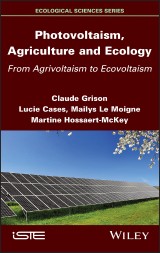Details

Photovoltaism, Agriculture and Ecology
From Agrivoltaism to Ecovoltaism1. Aufl.
|
139,99 € |
|
| Verlag: | Wiley |
| Format: | |
| Veröffentl.: | 20.12.2021 |
| ISBN/EAN: | 9781119887706 |
| Sprache: | englisch |
| Anzahl Seiten: | 176 |
DRM-geschütztes eBook, Sie benötigen z.B. Adobe Digital Editions und eine Adobe ID zum Lesen.
Beschreibungen
One of the challenges of our modern society is to successfully reconcile growing energy demand, demographic and food pressure and ecological and environmental urgency.<br /><br />This book offers an update on a rapidly evolving subject, that of modern photovoltaic systems capable of combining the needs of energy and ecological transition. Although photovoltaic solar energy is a well-proven technical solution in terms of energy, its development can compete with agricultural land or natural sites.<br /><br />New solutions are emerging: the installation of photovoltaic parks on industrial wasteland; agrivoltaics, which reconcile agricultural activity and energy production on the same surface; and ecovoltaics, which make it possible to make use of the unused surfaces under solar panels by developing ecological solutions capable of providing services to nature. These innovations are part of the response to the need to preserve terrestrial and aquatic ecosystems, halt the decline in animal and plant biodiversity and participate in the development of a new mode of sustainable development and green economy.
<p>Foreword by Yvon Le Maho ix</p> <p>Foreword by Thomas Lesueur xiii</p> <p>Introduction xv</p> <p><b>Chapter 1. Photovoltaics: Concepts and Challenges 1</b></p> <p>1.1. Brief description of the different photovoltaic cell technologies 1</p> <p>1.1.1. Photovoltaic versus thermal solar panels 9</p> <p>1.2. Different types of photovoltaic installations 9</p> <p>1.3. Legislation 10</p> <p>1.4. Advantages of photovoltaics 11</p> <p>1.5. Disadvantages of photovoltaics 12</p> <p>1.6. Some figures on the environmental footprint compared to other energy sources 13</p> <p>1.7. Origin of the silicon needed for the construction of photovoltaic cells 16</p> <p>1.8. End of life of solar panels 17</p> <p>1.9. Degree of maturity of material recycling 17</p> <p>1.10. Location and mode of development of photovoltaics 18</p> <p>1.10.1. Photovoltaic panels on roofs 18</p> <p>1.10.2. Ground-mounted photovoltaic panels: creating solar fields on unused industrial wastelands and parking lots 26</p> <p>1.10.3. Creating solar fields in arid areas 32</p> <p>1.10.4. Creating photovoltaic parks on water 35</p> <p><b>Chapter 2. Photovoltaic Energy Production and Agricultural Activity: Agrivoltaics 37</b></p> <p>2.1. Definition–legislation–adaptation and evolution of techniques 38</p> <p>2.2. Food crops 45</p> <p>2.2.1. Fish farming 46</p> <p>2.2.2. Oyster farming 47</p> <p>2.2.3. Viticulture 49</p> <p>2.2.4. Arboriculture and fruit production 50</p> <p>2.2.5. Field crops 53</p> <p>2.2.6. Market gardening: shades, greenhouses, protective structures for environmental conditions 54</p> <p>2.2.7. Other crops 55</p> <p>2.2.8. Pasture and livestock 57</p> <p><b>Chapter 3. Innovative Principle of Ecovoltaics 63</b></p> <p>3.1. Definition and concept 63</p> <p>3.2. State of the art: feedback 64</p> <p>3.2.1. Constraints of the experimental site in Occitanie 64</p> <p>3.2.2. Planting of species of interest in biodynamic agriculture on the grounds of solar parks 69</p> <p>3.2.3. Planting of melliferous species 81</p> <p>3.2.4. Installation of regionally endangered species 88</p> <p>3.2.5. Installation of medicinal species 89</p> <p>3.3. Assessment – issues 91</p> <p>3.3.1. Positive impact on soil quality 91</p> <p>3.3.2. Positive impact on faunal biodiversity 93</p> <p>3.4. Perspectives 97</p> <p>3.4.1. Regulations for the marketing of plants or plant extracts for use in biodynamic agriculture 97</p> <p>Appendices 103</p> <p>Appendix 1 105</p> <p>Appendix 2 113</p> <p>Appendix 3 115</p> <p>References 121</p> <p>Index 135 </p>
<b>Claude Grison</b> is a Research Director at the CNRS and a national corresponding member of the National Academy of Pharmacy. She is the originator of a new concept, that of ecological chemistry.<br /><br /><b>Lucie Cases</b> is a Chemical Engineer at the CNRS in the ChimEco laboratory. A graduate of the National School of Chemistry in Montpellier, she specializes in sustainable chemistry.<br /><br /><b>Mailys Le Moigne</b> is a Student Engineer at the Purpan School, Toulouse, specializing in agriculture, agri-food and the environment.<br /><br /><b>Martine Hossaert-McKey</b> is an Emeritus Research Director at the CNRS in the ChimEco laboratory and at the CEFE in Montpellier. She is also in charge of Biodiversity and Overseas Missions for the CNRS.


















